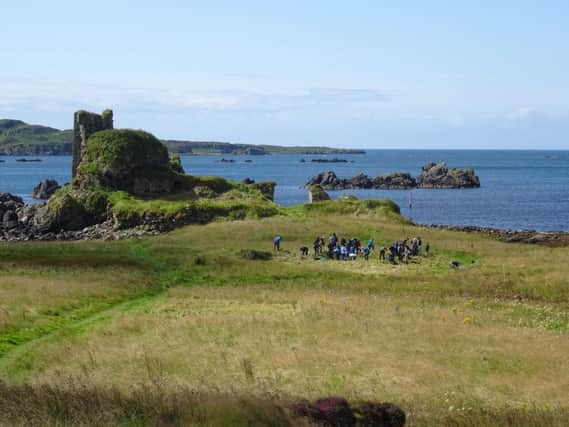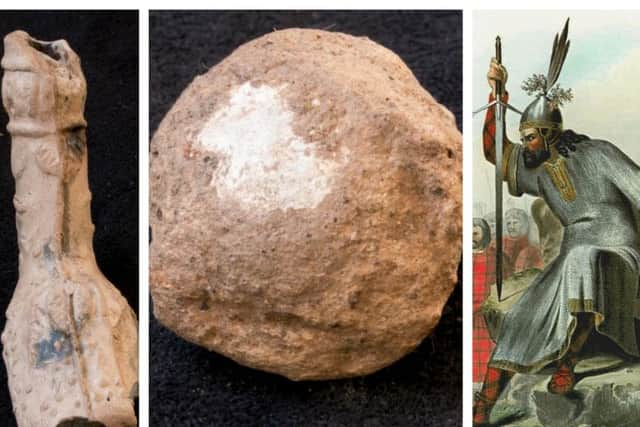Secrets of island castle ruled by powerful Lords of the Isles revealed


Dunyvaig Castle in Islay was a Macdonald stronghold during the 14th and 15th centuries with the fortress overlooking the Bay of Lagavulin and the waterways off the south coast of the island.
The fortress came under repeated attack and counter attack in the 16th and 17th Centuries as the Campbells tried to capture Islay and assert their supremacy in the western Atlantic seaboard.
Advertisement
Hide AdAdvertisement
Hide Ad

Now, new understanding of the importance of the castle to the Lordship - which controlled the Inner and Outer Hebrides, part of the west coast mainland and Ulster - has emerged following excavations by a team from University of Reading, University of Highlands and Islands and Islay Heritage.
Professor Steve Mithen, of the University of Reading, said Dunyvaig was the naval powerbase of the island dynasty where much of the day-to-day management of the Lordship occurred.
Prof Mithen said: “Looking out from Dunyvaig, one has got to imagine the huge fleets of birlinns, maybe 50 to 100 of these medieval galley boats, in the Bay of Lagavulin. Sea power was the critical way of gaining power and authority in this period.
"I suspect Dunyvaig had a much more important day-to-day role than Finlaggan, which was the council and ceremonial base of the Lords of the Isles. Finlaggan is inland, and it is not accessible in they way that Dunyvaig is.
“The fact that the Campbells and the Macdonalds fought so much over Dunyvaig in the 15th, 16th and 17th Centuries shows its strategic value.”
Dunyvaig is also the only castle on the western Atlantic seaboard to have a sea-gate, with accounts detailing successful escapes from the besieged castle with a small boat via the opening, which measured 17-foot wide. It may also have been used to drag in boats from the sea into the main castle complex for repairs or to shelter from storms.
It was found that half of the sea-gate was latterly blocked off, suggesting it no longer needed to cater for the large galley ships.
Nearby, a flight of steps leading from the courtyard down to the sea at high tide and the shore at low tide was discovered for the first time.
Advertisement
Hide AdAdvertisement
Hide AdProf Mithen said: “We suspect these were more of the changes made to the castle once first captured by the Campbells, and the heavy burning we found over the steps further evidence for the later conflict. One can readily imagine the insurgent MacDonalds fighting their way up the steps in an attempt to regain control of their ancestral castle. No one knew these steps were there.”
The fragment of what is believed to be a medieval brooch, or perhaps a shield boss or scabbard, was discovered in this area. Other finds include part of a 17th Century clay tobacco pipe, the remains of pig and cattle bones and a scattering of musket balls.
The discovery of lead seal matrix of Sir John Campbell of Cawdor in a complex of previously unknown buildings, suggest Dunyvaig was used as administrative centre by the Campbells following its power grab.
The buildings, which included metal workshops, were all burnt down with remains of charred thatch found on their clay floors.
Prof Mithen said: “Prior to the excavations, Dunyvaig was always known to be of great historical significance but its true value is now being revealed. It is a veritable treasure trove of finds that provide us with unique insights in the history of the castle, of Islay and western Scotland.
“However, the castle remains under threat – its walls are crumbling from the impact of storms, sea-spray and rising sea level, with a constant threat of masonry collapse. Repairs and consolidation of its fabric are urgently required.”
Funds are being sought from Historic Environment Scotland and others to protect the castle with excavations due to resume in August 2020.
The castle is owned by Lagavulin Distillery and its parent company Diageo, who have helped to finance the archaeological work at the site.
